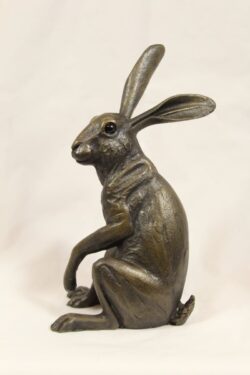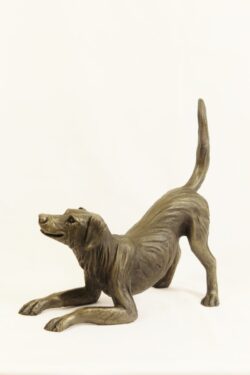Description
bronze resin Otters hunting fish
Otters are so graceful in the water, twisting this way and that with effortless grace, a picture of power and purpose. The again when you are hunting creatures as fast, slippery and so well adapted to life in water as fish, nothing less would come close to being adequate.
Otters
One of my favourite books when I was a child was Tarka the Otter by Henry Williamson, although I cried at the end. Thank goodness Otter hunting was made illegal in 1978
Brown above and cream below, these long, slender creatures are well-equipped for their aquatic habits. Their bones show osteosclerosis, increasing their density to reduce buoyancy.
Otters are one of our top predators, feeding mainly on fish, waterbirds, amphibians and crustaceans. They have their cubs in underground burrows, known as a ‘holt’. Excellent and lithe swimmers, the young are in the water by 10 weeks of age. Otters are well suited to a life on the water as they have webbed feet, dense fur to keep them warm and can close their ears and nose when underwater. For the best chances of seeing an otter in the wild, try the west coast of Scotland, the Shetland Islands or some parts of Wales, northern England and East Anglia
Otters can be distinguished from Mink by their much larger size, more powerful body, paler grey-brown fur, broader snout and broader, pale chest and throat.
The Otter is a rare but widespread animal, now found almost throughout the country, but absent from parts of central and southern England, the Isle of Man, the Isles of Scilly and the Channel Islands.
The Otter was nearly wiped out during the 20th century through a combination of pesticide poisoning, persecution and habitat destruction. Luckily, they are now on the increase again thanks to the cleaning up of our rivers and waterways, the banning of harmful pesticides and hunting, and numerous conservation projects across the country to provide suitable habitat for them. The Wildlife Trusts have led the way on such projects, but many local Trusts still need help with habitat improvements, holt-building and surveying to encourage these wonderful creatures back to our rivers. So why not have a go at volunteering for your local Trust? You’ll make new friends, learn new skills and help wildlife along the way. Go to www.wildlifetrusts.org to find out more or to join your local trust











